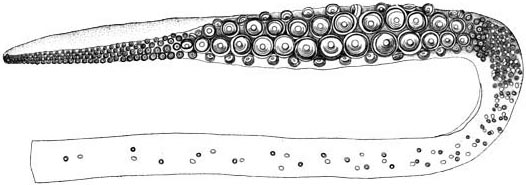|
Гћingeyrar
Þingeyrar (Thingøre in some older texts) is a farm in Iceland's Northwestern Region. It lies adjacent to the sandy coastal plain of Þingeyrasandur (or Thingøresand), between the Skagi and Vatnsnes peninsulas and just northeast of lake Hóp. Þingeyrar was formerly the location of the famous convent Þingeyraklaustur (1133–1551). It is also the site of Iceland's first stone church, Þingeyrakirkja. Icelandic scholar and politician Björn M. Ólsen (1850–1919) was born in Þingeyrar. Bjarni Halldórsson (c. 1703–1773), an Icelandic legal figure and theologian, spent most of his life in Þingeyrar. One of the earliest recorded giant squid The giant squid (''Architeuthis dux'') is a species of deep-ocean dwelling squid in the family Architeuthidae. It can grow to a tremendous size, offering an example of abyssal gigantism: recent estimates put the maximum size at around Trace ... (''Architeuthis dux'') specimens was found washed ashore on Þingeyrasandur in 1 ... [...More Info...] [...Related Items...] OR: [Wikipedia] [Google] [Baidu] |
Гћingeyrakirkja
Гћingeyrakirkja is an Icelandic church situated between lakes HГіp (Iceland), HГіp and HГєnavatn at Гћingeyrar in Iceland's Northwestern Region (Iceland), Northwestern Region. It was consecrated on 9 Sept. 1877 by the Reverend EirГkur Briem from Steinnes. Гћingeyrakirkja is a stone church which replaced an old turf church, the objects from which were moved to Гћingeyrakirkja . Among the valuable items are an alabastar altarpiece most likely dating from the 13th century, and a pulpit estimated to be of Dutch origin from the year 1696. The pulpit was a gift from LГЎrus GottrГєp, a lawyer who resided at Гћingeyraklaustur, Гћingeyrar Monastery (''Гћingeyraklaustur'') from 1683 to 1721. He also gave a silver baptismal font inscribed with the dates 1663 and 1697. A silver chalice and an Altar cloth, altar linen from 1763 are also among the church's historically valuable possessions. ГЃsgeir Einarsson (1809–1885) was largely responsible for the church's construction. Einarsson ... [...More Info...] [...Related Items...] OR: [Wikipedia] [Google] [Baidu] |
Гћingeyraklaustur
Гћingeyraklaustur was a monastery of the Order of Saint Benedict located in Гћingeyrar on Iceland from 1133 until 1551. It was the first convent in Iceland and likely the last to be closed by the Icelandic Reformation. History The convent was founded by bishop JГіn Г–gmundsson in 1106, but it was not inaugurated until 1133, when its first abbot, Vilmundur ГћГіrГіlfsson, was officially installed in office. JГіn Г–gmundsson assured the monastery an income from all farms between HrГєtafjГ¶rГ°ur and VatnsdalsГЎ. Гћingeyraklaustur was one of the largest and richest of the convents on Iceland. It was a famous center of literature, culture and education, and was known for its library. ArngrГmr Brandsson, Karl JГіnsson, Gunnlaugr Leifsson and Oddr Snorrason were all members of the convent and active as writers here, and the writer Styrmer KГҐresson is believed to have been educated here. A large number of Sagas of Icelanders were either produced or copied here, and the famous ''Bandama ... [...More Info...] [...Related Items...] OR: [Wikipedia] [Google] [Baidu] |
Bjarni HalldГіrsson
Bjarni HalldГіrsson (c. 1703 – 1773) was an Icelandic legal figure and theologian. He is best known for being a county magistrate. He first lived in VГГ°idalstungu but most of his life he lived in Гћingeyrar Гћingeyrar (ThingГёre in some older texts) is a farm in Iceland's Northwestern Region. It lies adjacent to the sandy coastal plain of Гћingeyrasandur (or ThingГёresand), between the Skagi and Vatnsnes peninsulas and just northeast of lake HГіp. .... References JГіn EspГіlГn: ГЌslands ГЃrbГ¦kur Г sГ¶gu-formi. X. deild, prentaГ° ГЎ kostnaГ° ens Гslenzka BГіkmenntafГ©lags, KaupmannahГ¶fn 1848. BlaГ°sГГ°a 34. (LjГіsprentuГ° 2. ГєtgГЎfa 1947.) 18th-century Icelandic judges Icelandic theologians 1703 births 1773 deaths {{Iceland-bio-stub ... [...More Info...] [...Related Items...] OR: [Wikipedia] [Google] [Baidu] |
Route 1 (Iceland)
Route 1 or the Ring Road ( or ) is a national road in Iceland that circles the entire country. As a major trunk route, it is considered to be the most important piece of transport infrastructure in Iceland as it connects the majority of towns together in the most densely populated areas of the country. Economically, it carries a large proportion of goods traffic as well as tourist traffic. The total length of the road is . The road was completed in 1974, coinciding with the 1,100th anniversary of the country's settlement when the longest bridge in Iceland, crossing the SkeiГ°arГЎ river in the southeast, was opened. Previously, vehicles intending to travel between southern settlements, e.g. VГk to HГ¶fn, had to travel north of the country through Akureyri, making the opening a major transport improvement to the country. Many popular tourist attractions in Iceland, such as the Seljalandsfoss and SkГіgafoss waterfalls, DyrhГіlaey cliffs, JГ¶kulsГЎrlГіn glacier lagoon, as well ... [...More Info...] [...Related Items...] OR: [Wikipedia] [Google] [Baidu] |
William James Rees
William James Rees (1913–1967) was a British hydroid and cephalopod researcher at the Natural History Museum in London London is the capital and largest city of England and the United Kingdom, with a population of just under 9 million. It stands on the River Thames in south-east England at the head of a estuary down to the North Sea, and has been a majo ....Crawford, G.I. 1968. Obituary: W. J. Rees, D.Sc., 1913–1967. ''Proceedings of the Malacological Society of London'' 38(2): 103–106. He described a number of species, including '' Sepia dubia'', '' Sepia sewelli'', and '' Sepia thurstoni''. References 20th-century British zoologists Teuthologists 1913 births 1967 deaths {{UK-zoologist-stub ... [...More Info...] [...Related Items...] OR: [Wikipedia] [Google] [Baidu] |
Giant Squid
The giant squid (''Architeuthis dux'') is a species of deep-ocean dwelling squid in the family Architeuthidae. It can grow to a tremendous size, offering an example of abyssal gigantism: recent estimates put the maximum size at around Tracey, D. M., O. F. Anderson & J. R. Naylor (2011)''A guide to common deepsea invertebrates in New Zealand waters. Third edition.''National Institute of Water and Atmospheric Research, Wellington. 317 pp.Yukhov, V. L. (2014)Гигантские кальмары рода ''Architeuthis'' в Южном океане / Giant calmaries ''Аrchiteuthis'' in the Southern ocean igantskiye kalmary roda ''Architeuthis'' v Yuzhnom okeane.''Ukrainian Antarctic Journal'' no. 13: 242–253. for females and for males, from the posterior fins to the tip of the two long tentacles (longer than the colossal squid at an estimated , but substantially lighter, due to the tentacles making up most of the length). The mantle of the giant squid is about long ... [...More Info...] [...Related Items...] OR: [Wikipedia] [Google] [Baidu] |
List Of Giant Squid Specimens And Sightings
This list of giant squid specimens and sightings is a comprehensive timeline of recorded human encounters with members of the genus ''Giant squid, Architeuthis'', popularly known as giant squid. It includes animals that were caught by fishermen, found washed ashore, recovered (in whole or in part) from sperm whales and other predatory species, as well as those reliably sighted at sea. The list also covers specimens incorrectly assigned to the genus ''Architeuthis'' in original descriptions or later publications. Background History of discovery Tales of giant squid have been common among mariners since ancient times, but the animals were long considered Legendary creature, mythical and often associated with the kraken of Nordic legend. The giant squid did not gain widespread scientific acceptance until specimens became available to zoologists in the second half of the 19th century, beginning with the species description, formal naming of ''Architeuthis dux'' by Japetus Stee ... [...More Info...] [...Related Items...] OR: [Wikipedia] [Google] [Baidu] |
Björn M
Bjorn (English, Dutch), Björn (Swedish, Icelandic, Dutch, and German), Bjørn (Danish, Faroese and Norwegian), Beorn (Old English) or, rarely, Bjôrn, Biorn, or Latinized Biornus, Brum (Portuguese), is a Scandinavian male given name, or less often a surname. The name means "bear" (the animal). In Finnish and Finland Swedish, sometimes also in Swedish, the nickname Nalle ("teddy bear") refers to Björn. Surname *Claus Bjørn, Danish author, historian, and television and radio broadcaster *Evert Björn, Swedish Olympic athlete *Hugo Björne, Swedish actor *Kristian Bjørn, Norwegian skier * Lars "Lasse" Björn, Swedish Olympic ice hockey player *Thomas Bjørn, Danish golfer Given name Acting *Björn Andrésen, Swedish actor and musician *Björn Bjelfvenstam, Swedish actor *Björn Granath, Swedish actor *Björn Gustafsson, Swedish comedian and actor *Björn Kjellman, Swedish actor and singer *Björn Skifs, Swedish singer and actor Art and music *Björn Afzelius, Swedish musician ... [...More Info...] [...Related Items...] OR: [Wikipedia] [Google] [Baidu] |
HГіp (Iceland)
The lake Hóp () is situated in the north of Iceland near Blönduós at the Húnafjörður. In reality, the lake is more of a lagoon than a lake. Its surface area depends on the tides and oscillates between 29 and 44 km2. Its greatest depth is 9 m. See also *List of lakes of Iceland This is a list of lakes of Iceland (partially indicating surface, depth and volume). Iceland has over 20 lakes larger than 10 km² (4 sq mi), and at least 40 others varying between 2.5 and 10 km² (1 to 4 sq mi) in size. This list also in ... Lagoons of Europe Bodies of water of Iceland {{Iceland-geo-stub ... [...More Info...] [...Related Items...] OR: [Wikipedia] [Google] [Baidu] |
Iceland
Iceland ( is, ГЌsland; ) is a Nordic island country in the North Atlantic Ocean and in the Arctic Ocean. Iceland is the most sparsely populated country in Europe. Iceland's capital and largest city is ReykjavГk, which (along with its surrounding areas) is home to over 65% of the population. Iceland is the biggest part of the Mid-Atlantic Ridge that rises above sea level, and its central volcanic plateau is erupting almost constantly. The interior consists of a plateau characterised by sand and lava fields, mountains, and glaciers, and many glacial rivers flow to the sea through the lowlands. Iceland is warmed by the Gulf Stream and has a temperate climate, despite a high latitude just outside the Arctic Circle. Its high latitude and marine influence keep summers chilly, and most of its islands have a polar climate. According to the ancient manuscript , the settlement of Iceland began in 874 AD when the Norwegian chieftain IngГіlfr Arnarson became the first p ... [...More Info...] [...Related Items...] OR: [Wikipedia] [Google] [Baidu] |
Vatnsnes
Vatnsnes () is a peninsula jutting into HГєnaflГіi in northern Iceland. It is surrounded by waters of MiГ°fjГ¶rГ°ur on the west and HГєnafjГ¶rГ°ur on the east. It is home to one of the largest seal colonies in Iceland, among others at HindisvГk and Г“sar . Seals have been protected for many years in HindisvГk. A stone hut was built at Г“sar on the eastern side of the peninsula for seal watching. Among geological features of Vatnsnes are Borgarvirki, a volcanic plug mentioned for its use as a fortress in the Sagas of Icelanders, and HvГtserkur (, regionally also ) is a 15 m high basalt Stack (geology), stack along the eastern shore of the Vatnsnes peninsula, in Northwestern Region (Iceland), northwest Iceland. The rock has two holes at the base, which give it the appearance of a ..., a 15 m high basalt rock formation near the eastern shore of the peninsula. References North Iceland Peninsulas of Iceland {{iceland-geo-stub ... [...More Info...] [...Related Items...] OR: [Wikipedia] [Google] [Baidu] |


.jpg)

